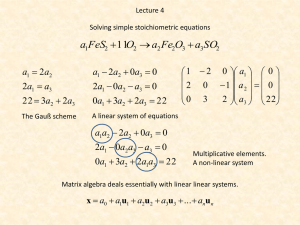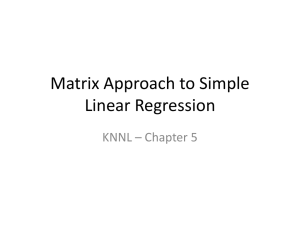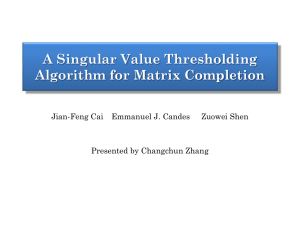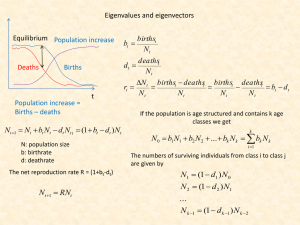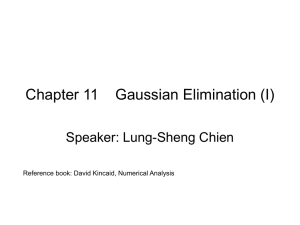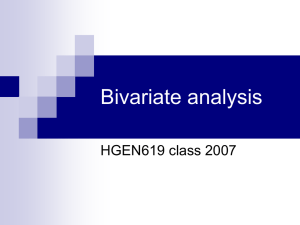Matrix algebra II
advertisement
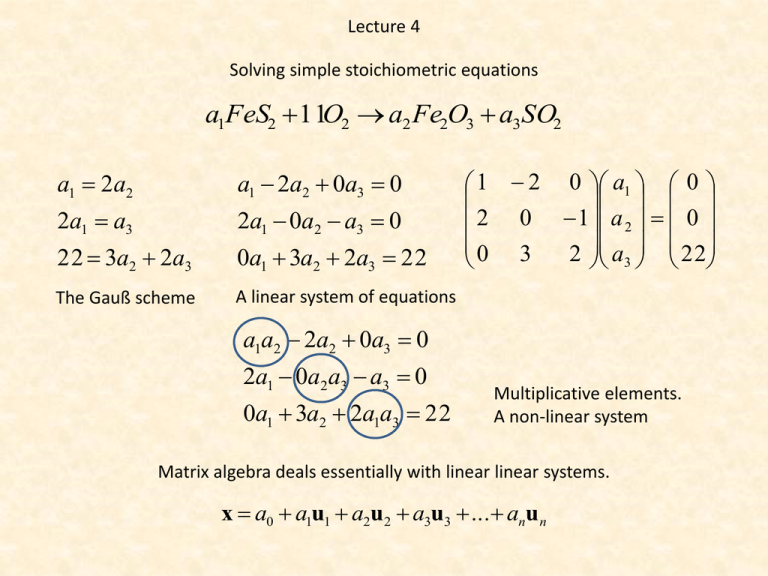
Lecture 4
Solving simple stoichiometric equations
a1FeS2 11O2 a2 Fe2O3 a3SO2
a1 2a2
a1 2a2 0a3 0
2a1 a3
2a1 0a2 a3 0
22 3a2 2a3
0a1 3a2 2a3 22
The Gauß scheme
A linear system of equations
1 2 0 a1 0
2 0 1 a 2 0
0 3
2 a3 22
a1a2 2a2 0a3 0
2a1 0a2 a3 a3 0
0a1 3a2 2a1a3 22
Multiplicative elements.
A non-linear system
Matrix algebra deals essentially with linear linear systems.
x a0 a1u1 a2u2 a3u3 ... anun
Solving a linear system
1 2 0 a1 0
2 0 1 a 2 0
0 3
2 a3 22
a1 0 1 2 0
a 2 0 / 2 0 1
a 22 0 3
2
3
The division through a vector or a matrix is not defined!
a11 a12
b1
; B
A
a
a
22
21
b2
a11b1 a12b2
c1
C
A B
a
b
a
b
21 1 22 2
c2
C c1 b1 a11 a12
/
B c2 b2 a21 a22
c1 a11b1 a12b2
c2 a21b1 a22b2
2 equations and four unknowns
For a non-singular square matrix
the inverse is defined as
A A 1 I
A 1 A I
A matrix is singular if it’s
determinant is zero.
a
A 11
a21
a12
a22
a
DetA A 11
a21
Singular matrices are those where some rows or
columns can be expressed by a linear
combination of others.
Such columns or rows do not contain additional
information.
They are redundant.
1 2 3
A 2 4 6
7 8 9
r2=2r1
a12
a11a22 a21a12
a22
Det A: determinant of A
1 2 3
A 4 5 6
6 9 12
r3=2r1+r2
A linear combination of vectors
V k1V1 k2V2 k3V3 ... kn Vn
A matrix is singular if at least one
of the parameters k is not zero.
The inverse of a 2x2 matrix
a
A 11
a12
a21
a22
a22
1
A
a11a22 a12 a21 a12
Determinant
1
a21
a11
The inverse of a square matrix only exists
if its determinant differs from zero.
Singular matrices do not have an inverse
The inverse of a diagonal matrix
a11
0
A
...
0
1
a11
0
1
A
...
0
0
0
... ...
... ann
0 ...
a22 ...
...
0
0
1
a22
...
0
0
... 0
... ...
1
...
ann
...
(A•B)-1 = B-1 •A-1 ≠ A-1 •B-1
The inverse can be unequivocally calculated by the Gauss-Jordan algorithm
Solving a simple linear system
1
a1FeS2 11O2 a2 Fe2O3 a3SO2
1
1 2 0 1 2 0 a1 a1 a1 1 2 0 0
2 0 1 2 0 1 a 2 I a 2 a 2 2 0 1 0
0 3
2 0 3
2 a3 a3 a3 0 3
2 22
4FeS2 11O2 2Fe2O3 8SO2
The general solution of a linear system
1 0 ...
0 1 ...
A 1A I
Identity matrix I
... ... ...
1
XA B
0 0 ...
Only possible if A is not singular.
IX XI X
If A is singular the system has no solution.
AX B A 1AX A 1B
3x 2 y 4 z 10
3x 3 y 8 z 12
9 x 0.5 y 2.3z 1
Systems with a unique solution
The number of independent equations
equals the number of unknowns.
2
4
3
3
8
3
9 0.5 2.3
1
0
0
...
1
2
4
3
3
8
3
9 0.5 2.3
X: Not singular
10 x 0.3819
12 y 4.5627
1 z 0.0678
2
4 10
3
3
8 12
3
9 0 .5 2 .3 1
The augmented matrix Xaug
is not singular and has the
same rank as X.
The rank of a matrix is
minimum number of
rows/columns of the largest
non-singular submatrix
A X B A 1 A X A 1 B X A 1 B
Consistent system
Solutions extist
rank(A) = rank(A:B)
Single
solution extists
rank(A) = n
Inconsistent system
No solutions
rank(A) < rank(A:B)
Multiple
solutions extist
rank(A) < n
a1 2a 2 a 3 2a 4 5
2a1 3a 2 2a 3 3a 4 6
3a1 4a 2 4a 3 3a 4 7
5a1 6a 2 7a 3 8a 4 8
1a1
2a1
3a
1
5a
1
1
2
3
5
2 a2
1a3
3a2
2a3
4 a2
4a3
6 a2
7 a3
1
2 1 2 1 2
3 2 3 2 3
3 4
4 4 3
6 7 8 5 6
a1 1
a2 2
a3 3
a4 5
1
2a4 1
3a4 2
3a4
3
8a4 5
2 1 2 a1 5
3 2 3 a2 6
a
4 4 3
7
3
6 7 8 a4 8
1 2 a1 1
2 3 a2 2
3
a3
4 3
7 8 a4 5
2 1 2 5
3 2 3 6
7
4 4 3
6 7 8 8
1
2 1 2 5
3 2 3 6
7
4 4 3
6 7 8 8
a1 2a 2 a 3 2a 4 5
2a1 3a 2 2a 3 3a 4 6
3a1 4a 2 4a 3 3a 4 7
5a1 6a 2 7a 3 8a 4 8
2x1 6x 2 5x 3 9x 4 10 2
2x1 5x 2 6x 3 7x 4 12
2
4x1 4x 2 7x 3 6x 4 14 4
5x1 3x 2 8x 3 5x 4 16
5
2x1 3x 2 4x 3 5x 4 10 2
4x1 6x 2 8x 3 10x 4 20
4
4x1 5x 2 6x 3 7x 4 14 4
5x1 6x 2 7x 3 8x 4 16
5
6
5
5
6
4
7
3
8
3
9 x1
7 x2
6 x3
5
x4
4
10
12
14
16
x1
x2
7 x3
8
x4
5
Infinite number of 6solutions
8 10
5
6
6
7
3
No solution
6
4
8
5
6
6
7
2x1 3x 2 4x 3 5x 4 10 2
4x1 6x 2 8x 3 10x 4 12
4
4x1 5x 2 6x 3 7x 4 14 4
5x1 6x 2 7x 3 8x 4 16
5
2x1 3x 2 6x 3 9x 4 10 2
2x1 4x 2 5x 3 6x 4 12 2
4x1 5x 2 4x 3 7x 4 14
4
3
5 x1
10 x 2
7 x3
8
x4
10
20
14
16
10
12
14
16
x1
9
10
x2
5 6
12
x3
14
4 7
x
4
3
4
5
10
x1
12
6
8
10
x2
14
5
6
7
x3
6
7
8
16
x
4
16
12 14 16
6
Infinite number of4 solutions
5
2x1 3x 2 4x 3 5x 4 10
2
4x1 6x 2 8x 3 10x 4 12
4
4x1 5x 2 6x 3 7x 4 14
4
5
5x1 6x 2 7x 3 8x 4 16
10x1 12x 2 14x 3 16x 4 16
10
No solution
2x1 3x 2 4x 3 5x 4 10
2
4x1 6x 2 8x 3 10x 4 12
4
4x1 5x 2 6x 3 7x 4 14
4
5
5x1 6x 2 7x 3 8x 4 16
10x1 12x 2 14x 3 16x 4 32
10
3
4
6
8
5
6
6
12
7
14
Infinite number of solutions
5
x1
10
x2
7
x3
8
x
4
16
10
12
14
16
32
Consistent
Rank(A) = rank(A:B) = n
Consistent
Rank(A) = rank(A:B) < n
Inconsistent
Rank(A) < rank(A:B)
Consistent
Rank(A) = rank(A:B) < n
Inconsistent
Rank(A) < rank(A:B)
Consistent
Rank(A) = rank(A:B) = n
n1KOH n2Cl2 n3 KClO3 n4 KCl n5 H 2O
n1 n3 n4
n1 n3 n4 0
n1 3n3 n5
n1 3n3 n5
n1 2n5
n1 2n5
2n2 n3 n4
2n2 n3 n4 0
We have only four
equations but five
unknowns.
The system is
underdetermined.
n1
1
1
1
0
Inverse
0
-0.5
0
-1
n2
0
0
0
2
n3
-1
-3
0
-1
0
1
0
0.5
-0.33333 0.333333
0.333333 0.666667
1
1
1
0
n4
-1
0
0
-1
0
0.5
0
0
1 1 n1 0
0 3 0 n2 1
n5
0 0
0 n3
2
2 1 1 n4 0
0
A
0
1
2
0
N*n5
2
1
0.333333
1.666667
n1
n2
n3
n4
n5
6
3
1
5
3
The missing value is found by dividing the vector through its
smallest values to find the smallest solution for natural numbers.
6KOH 3Cl2 KClO3 5KCl 3H 2O
n1Mga1Sia 2 n2 Na3 H a 4Bra5 n3Sia6 H a7 n4 Na8 H a9 n5 Mga10 Bra11
Equality of
atoms involved
n1a1 n5 a10
n1a2 n3 a6
n2 a3 n4 a8
n2 a4 n4 a9 n3 a7
n2 a5 n5 a11
Including
information on
the valences of
elements
a1 2a2
a4 a3 a5
a7 4 a 6
a8 4(a9 1)
a10 2a11
We have 16 unknows but without
experminetnal information only 11 equations.
Such a system is underdefined.
A system with n unknowns needs at least n
independent and non-contradictory equations
for a unique solution.
a1 a11
If ni and ai are unknowns we have a non-linear situation.
We either determine ni or ai or mixed variables such that no multiplications occur.
n1a1 n5 a10
n1a2 n3 a6
n2 a3 n4 a8
n2 a4 n4 a9 n3 a7
n2 a5 n5 a11
a1 2a2
a4 a3 a5
a7 4 a 6
a8 4(a9 1)
a10 2a11
a1 a11
0
n1 0 0 0 0
n1 0 0 0 0 n3
0 0 n2 0 0
0
0
0 0 0 n2 0
0 0 0 0 n2
0
2 1 0 0 0
0
0 0 1 1 1 0
0 0 0 0 0 4
0
0 0 0 0 0
0 0 0 0 0
0
0
1 0 0 0 0
0
0
0
n5
0 a1 0
0
0
0
0
0 a 2 0
0
0
n4
0
0 a3 0
0 n3
0
n4
0 a 4 0
0
0
0
0
n5 a5 0
0
0
0
0
0 a6 0
0
0
0
0
0 a7 0
1
0
0
4
0 a8 0
0
1
4
0
0 a9 4
0
0
0
1
2 a10 0
0
0
0
0
1 a11 0
The matrix is singular because a1, a7, and a10 do
not contain new information
Matrix algebra helps to determine what information is needed
for an unequivocal information.
n1Mga1Sia 2 n2 Na3 H a 4Bra5 n3Sia6 H a7 n4 Na8 H a9 n5 Mga10 Bra11
From the knowledge of the salts we get n1 to n5
n1Mga1Sia 2 n2 Na3 H a 4Bra5 n3Sia6 H a7 n4 Na8 H a9 n5 Mga10 Bra11
Mg2 Si 4Na3 H a 4Bra5 SiHa7 4Na8 H a9 2MgBr2
a4 3a3 a5
a3 a8
4 a 4 a 7 4 a9
4a5 4
a8 1
a9 3
3
1
0
0
0
0
1 1
0
0
4
0
0
1
0
0
0
0
a3
a4
a5
a7
a8
a9
Inverse
0 a3 0
0 1 0 a4 0
1 0 4 a5 0
0 0
0 a7 1
0 1
0 a8 1
0 0
1 a9 3
0
0
We have six variables and six
equations that are not
contradictory and contain
different information.
The matrix is therefore not
singular.
a3
-3
1
0
0
0
0
a4
1
0
4
0
0
0
a5
-1
0
0
1
0
0
a7
0
0
-1
0
0
0
a8
0
-1
0
0
1
0
a9
0
0
-4
0
0
1
0
1
0
4
0
0
1
3
0
12
0
0
0
0
0
-1
0
0
0
1
1
4
0
0
1
3
0
12
1
0
0
0
0
-4
0
1
A
0
0
0
1
1
3
a3
a4
a5
a7
a8
a9
Mg2 Si 4NH 4Br SiH4 4NH 3 2MgBr2
1
4
1
4
1
3
Linear models in biology
The logistic model of population growth
r 2
N rN N c
K
t
1
2
3
4
N
1
5
15
45
We need four
measurements
r
4 1r 1 c
K
r
10 5r 25 c
K
r
30 15r 225 c
K
1 1 r
4 1
10 5 15 1 r / K
30 15 225 1 c
K denotes the maximum possible density
under resource limitation, the carrying
capacity.
r denotes the intrinsic population growth
rate. If r > 1 the population growths, at r < 1
the population shrinks.
K 1.286 / 0.036 36
Population growth
N 1.286 N
t
1
2
3
4
5
6
7
8
9
10
1.286 2
N 2.679
36
N
1
4.928571
13.07635
26.46055
38.15409
37.8974
38.00788
37.96091
37.98099
37.97242
N
3.928571
8.147777
13.3842
11.69354
-0.25669
0.110482
-0.04698
0.02008
-0.00856
0.003656
We have an overshot.
In the next time step the population should
decrease below the carrying capacity.
N
K
Overshot
K/2
N (t 1) N (t ) N (t )
N (t 1) N 1.286N
1.286 2
N 2.679
36
Fastest
population
growth
t
The transition matrix
Assume a gene with four different alleles. Each allele can mutate into anther allele.
The mutation probabilities can be measured.
A→A
B→A
C→A
D→A
A→A 0.997 0.001 0.001 0.001
A→B 0.001 0.994 0.001 0.004
A→C 0.001 0.003 0.995 0.004
A→D 0.001 0.002 0.003 0.991
Sum
1
1
1
Initial allele frequencies
0.4
0.2
0.3
0.1
1
What are the
frequencies in the
next generation?
Transition matrix
Probability matrix
A(t 1) 0.4 * 0.997 0.2 * 0.001 0.3 * 0.001 0.1* 0.001 0.3994
B(t 1) 0.4 * 0.001 0.2 * 0.994 0.3 * 0.001 0.1* 0.004 0.1999
C (t 1) 0.4 * 0.001 0.2 * 0.003 0.3 * 0.995 0.1* 0.004 0.2999
D(t 1) 0.4 * 0.001 0.2 * 0.002 0.3 * 0.003 0.1* 0.991 0.1008
A(t 1) 0.997
B(t 1) 0.001
C (t 1) 0.001
D(t 1) 0.001
0.001 0.001
0.994 0.001
0.003 0.995
0.002 0.003
F(t 1) PF(t )
0.001 A(t )
0.004 B(t )
0.004 C (t )
0.991 D(t )
Σ=1
The frequencies at time
t+1 do only depent on
the frequencies at time t
but not on earlier ones.
Markov process
Does the mutation process result in stable allele frequencies?
A(t 1) A(t ) 0.997
B(t 1) B(t ) 0.001
C (t 1) C (t ) 0.001
D(t 1) D(t ) 0.001
AN N
AN N 0
( A I ) N 0
0.001
0.994
0.003
0.002
0.001
0.001
0.995
0.003
0.001 A(t )
0.004 B(t )
0.004 C (t )
0.991 D(t )
AN N
Stable state vector
Eigenvector of A
Eigenvalue Unit matrix Eigenvector
A
B
C
D
A
B
C
D
0.997
0.001
0.001
0.001
0.001
0.994
0.001
0.004
0.001
0.003
0.995
0.004
0.001
0.002
0.003
0.991
Eigenvectors
0
0 0.842927 0.48866
0.555069 0.780106 -0.18732 0.43811
0.241044
-0.5988 -0.46829 0.65716
-0.79611
-0.1813 -0.18732
0.3707
Eigenvalues
0.988697
0.992303
0.996
1
Every probability
matrix has at least
one eigenvalue = 1.
The largest eigenvalue
defines the stable state
vector
The insulin – glycogen system
At high blood glucose levels insulin stimulates glycogen synthesis and inhibits
glycogen breakdown.
N fN g
The change in glycogen concentration N can be modelled
by the sum of constant production g and concentration
dependent breakdown fN.
At equilibrium we have
fN g N 0
f
N 1
g
0
1
D 2
N
N
1
2
The symmetric and square
matrix D that contains
squared values is called the
dispersion matrix
f
T
T
N 1 0 0
1 N 1
g
1 N 2 f
2
0
N
g
1
The vector {-f,g} is the stationary state vector (the
largest eigenvector) of the dispersion matrix and
gives the equilibrium conditions (stationary point).
0
2
N
The glycogen concentration at equilibrium:
N
N 2 1 0 f
1
0
0 0 1 g
The value -1 is the eigenvalue of
this system.
N equi
g
f
The equilbrium concentration
does not depend on the initial
concentrations
A matrix with n columns has n
eigenvalues and n eigenvectors.
Some properties of eigenvectors
If is the diagonal matrix
of eigenvalues:
The eigenvectors of symmetric
matrices are orthogonal
ΛU UΛ
A( sym m etric) :
AU UΛ AUU1 A UU 1
U' U 0
Eigenvectors do not change after a
matrix is multiplied by a scalar k.
Eigenvalues are also multiplied by k.
The product of all
eigenvalues equals the
determinant of a
matrix.
[ A I ]u [kA kI ]u 0
det A i 1 i
n
The determinant is zero if
at least one of the
eigenvalues is zero.
In this case the matrix is
singular.
If A is trianagular or diagonal the
eigenvalues of A are the diagonal
entries of A.
A
2
3
3
-1
2
4
3
-6
-5
5
Eigenvalues
2
3
4
5
Page Rank
Google sorts internet pages according to a ranking of websites based on the probablitites to
be directled to this page.
Assume a surfer clicks with probability d to a certain
website A. Having N sites in the world (30 to 50 bilion)
the probability to reach A is d/N.
Assume further we have four site A, B, C, D, with links
to A. Assume further the four sites have cA, cB, cC, and
cD links and kA, kB, kC, and kD links to A.
If the probability to be on one of these sites is pA, pB,
pC, and pD, the probability to reach A from any of the
sites is therefore
dk
dk
dk
p A pB
B A
cB
pC
CA
cC
pD
D A
cD
p A pB
dkB A
dk
dk
pC C A pD D A
cB
cC
cD
The total probability to reach A is
pA
Google uses a fixed value of d=0.15.
Needed is the number of links per
website.
1
dkA B / c A
dk
AC / c A
dk
A D / c A
Probability matrix P
dk
dk
dk
d
pB B A pC C A pD D A
N
cB
cC
cD
pA
dk
d
dk
dk
pB B pC C pD D
N
cB
cC
cD
pB
dk
d
dk
dk
p A A pC C pD D
N
cA
cC
cD
pC
d
dk
dk
dk
p A A pB B pD D
N
cA
cB
cD
pD
dk
d
dk
dk
p A A pB B pC C
N
cA
cB
cC
dkB A / cB
dkC A / cC
1
dkB / cB C
dkC B / cC
1
dkB D / cB
dkC D / cC
dkD A / cD p A
d
dkD B / cD pB 1 d
dkD C / cD pC
N d
d
1
pD
Rank vector u
Internet pages are ranked according to probability to be reached
A
B
C
D
0
0
0 p A
1
0.15
p
0
.
15
1
0
.
15
0
.
075
0
.
15
B 1
0
0.15
1
0.075 pC 4 0.15
0
0
0
1 pD
0.15
P
A
B
C
D
1
-0.15
0
0
0
1
-0.15
0
0
-0.15
1
0
0
-0.075
-0.075
1
0.0375
0.0375
0.0375
0.0375
1
0
0
0
0.153453 1.023018 0.153453 0.088235
0.023018 0.153453 1.023018 0.088235
0
0
0
1
A
0.0375
B 0.053181
C 0.04829
D
0.0375
P-1
Larry Page
(1973-
Sergej Brin
(1973-
Page Rank as an eigenvector problem
0
0
0 p A
1
0.15
1
0.15 0.075 pB 1 0.15
0.15
0
0.15
1
0.075 pC 4 0.15
0
p
0.15
0
0
1
D
In reality the
constant is
very small
0
0
0 p A
1
1
0.15 0.075 pB
0.15
0
0
0.15
1
0.075 pC
0
p
0
0
1
D
0
0
0
0 1
0
.
15
0
0
.
15
0
.
075
0
0
0.15
0
0.075 0
0
0
0 0
0
A
B
C
D
0 0 0 p A
1 0 0 p B
0
0 1 0 pC
0 0 1 pD
A
B
C
D
0
0
0
0
-0.15
0
-0.15
-0.075
0
-0.15
0
-0.075
0
0
0
0
Eigenvectors
0 0.707107 0.408248
0
0.707107
0 0.408248 0.70711
0.707107 -0.70711
0 -0.7071
0
0
-0.8165
0
The final page rank is given
by the stationary state
vector (the vector of the
largest eigenvalue).
Eigenvalues
-0.15
0
0
0.15
0
0
0
0
Home work and literature
Refresh:
Literature:
• Linear equations
• Inverse
• Stochiometric equations
Mathe-online
Asymptotes:
www.nvcc.edu/home/.../MTH%20163
%20Asymptotes%20Tutorial.pp
http://www.freemathhelp.com/asymp
totes.html
Limits:
Pauls’s online math
http://tutorial.math.lamar.edu/Classe
s/CalcI/limitsIntro.aspx
Sums of series:
http://en.wikipedia.org/wiki/List_of_
mathematical_series
http://en.wikipedia.org/wiki/Series_(
mathematics)
Prepare to the next lecture:
•
•
•
•
Arithmetic, geometric series
Limits of functions
Sums of series
Asymptotes


